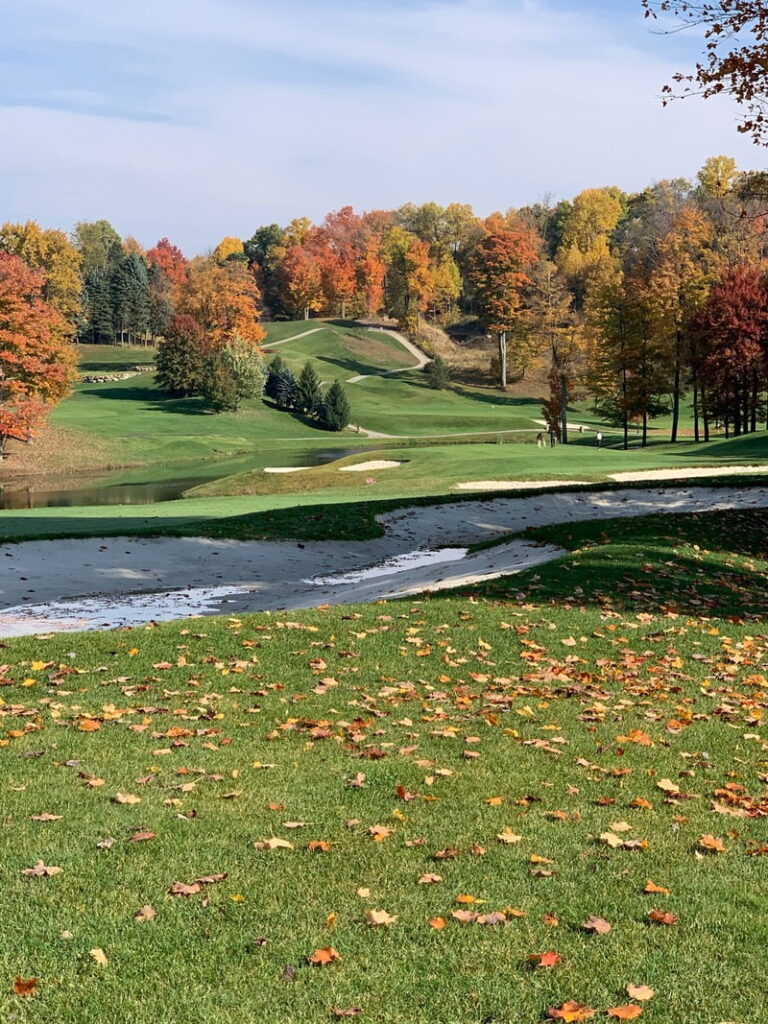Everyone who plays golf wants the same thing: the Golf Fairway. It’s a sign of hope and success. It’s that clean stretch of grass in front of them that looks like a road to victory.
But what does the fairway really mean, and why is it so important in golf? We look into its background, meaning, and how mastering it can help you improve your game in order to find out its secrets.
Picture this: When you walk onto the golf course with your golf club in hand, your eyes immediately go to the wide, green area that looks like a welcoming mat. That’s the Golf Fairway, the holy ground that every player aims to conquer with every swing.
The fairway isn’t just pretty; it’s also the way to the hole, which is the final goal. A green that is well taken care of has a smooth, danger-free surface that lets players use their skills with accuracy and style. Still, getting good at the fairway takes careful planning, accuracy, and knowledge of how it works.
This guide explores the mysterious aspects of the fairway, giving you tips on how to play on different types of fields, plan your shots, and make the most of this golfer’s paradise. Start getting ready for a journey that will change the way you see the field forever. Get ready to improve your golf game and take the fairway like a real winner.
The Origins and Evolution of the Golf Fairways

The fairway we know today has a long past that goes back hundreds of years. Its roots can be found in the early days of golf, when the game was played on rough, uneven ground. Back then, players had to get to their goal by going through fields, woods, and even sand dunes. That being said, as the game grew and became more organized, it became clear that it needed a clear playing area.
The 18th century was the first time that golf grounds made areas just for playing. To keep the playing field level, these areas were carefully mowed and cared for. This is where what we now call the “fairway” got its start.
Over time, improvements in turf management methods and tools have made it possible for golf course planners to make fairways that are not only nice to look at but also great for playing. The quality of the fairways got even better when grass types were introduced that were especially made for golf courses.
Today, greens on golf courses all over the world are well taken care of, showing that they are both traditional and modern. Each type of course, from lush parkland courses to rough links courses by the sea, has its own special feel on the fairways.
Understanding the Purpose of the Fairway in Golf
The fairway is an important part of every golfer’s path from the tee to the green. Furthermore, it serves a purpose beyond just making the playing field look nice; it also helps you do well on each hole.
One important part of a well-designed fairway is where it is placed in relation to dangers like water, bunkers, or thick roughs. Course designers test golfers’ ability to make decisions and hit the ball accurately by placing these features carefully along the edges of fairways or in landing zones.
Also, players of all skill levels can play on the fairway without any problems. The smooth surface lets players make clean touch with the ball, which makes shots more accurate and helps them go farther. Not only does this make golf more fun, but it also supports fair competition between players.
Anatomy of a Perfect Fairway: Grass Types and Maintenance
The perfect fairway is a harmonious blend of carefully selected grass types and meticulous maintenance practices. Different grass species are chosen based on factors such as climate, soil conditions, and expected foot traffic.
Warm-season grasses like Bermuda grass and Zoysia grass thrive in regions with hot summers, while cool-season grasses like Kentucky bluegrass and fescue are better suited for cooler climates. The choice of grass type directly impacts the playability and visual appeal of the fairway.
Maintenance practices play a vital role in ensuring that fairways remain in top condition throughout the year. Regular mowing, irrigation, fertilization, and pest control are essential to promote healthy turf growth and prevent weed invasion or disease outbreaks.
Golf course superintendents work tirelessly to maintain fairways at an optimal height, typically between 0.5 to 1 inch. This ensures that golfers can enjoy consistent ball lies while also adding an element of challenge by varying fairway widths throughout the course.
Navigating Different Types of Fairways: Links, Parkland, and Desert
Each golf course is a different size and shape, and each has its own style of green. We’ll look at three common types: desert courses, grass courses, and links courses.
Links courses are often found near the coast, where the ground is sandy. They have firm greens that let tee shots roll as far as possible, but you have to be smart about where you hit your ball to avoid pot bunkers and the terrain that slopes.
Parkland courses, on the other hand, tend to be found inland and have lush lawns that are surrounded by trees and other plants. These fairways are very different from links courses. They are easier to play on and award accuracy over distance.
As the name suggests, desert courses are set up in dry places where water is hard to come by. Most of the time, these fields have hard, packed surfaces with few plants growing on them. As golfers play, they have to find their way through desert landscapes and avoid desert dangers while taking in breathtaking views.
The Secrets to Getting Off the Tee and Hitting the Fairway

Hitting the fairway from the tee can be hard for a lot of players. But if you practice and think about it the right way, it can become a regular part of your game.
To begin, right alignment is very important. Make sure your feet, hips, and shoulders are all lined up properly and aligned parallel to your target line. This will help you swing in the right direction, which will improve your chances of hitting the green.
Second, pay attention to your swing’s speed and technique. When you hit the ball, you can control the clubface better when you swing smoothly and steadily. This helps you make more accurate shots. Don’t rush or force your swing; instead, let it happen easily.
Finally, work on your course organizing skills. Before you tee off, look at the plan of each hole and mark any possible trouble spots or hazards along the fairway. Make the necessary changes to your plan to lower your risks and raise your chances of finding the short grass.
Strategies for Approaching the Fairway: Layup or Go for the Green?
When you hit the fairway off the tee, you have to make another choice: should you lay up or go for the green? Several things affect this strategic decision, such as your level of skill, the distance to the hole, and any possible hazards.
When you “lay up,” you choose to hit a shorter shot that avoids trouble spots like fairway bunkers or water dangers. This careful technique is meant to make the next shot easier to handle and lower the chance of scoring too high on a hole.
Going for the green, on the other hand, means being more aggressive and trying to get to the putting area in one shot. When players can see the green clearly and are sure they can carry any hazards, they often use this type of play.
In the end, whether you lay up or go for the green rests on how comfortable you are and how much risk you are willing to take. It’s important to look at each situation with an open mind and pick the choice that gives you the best chance of getting what you want.
Mastering Fairway Bunkers: Techniques for a Successful Escape
People who play golf all the time can be scared of fairway bunkers. But with the right skills and experience, you can get good at getting out of these sandy traps without getting hurt.
Figuring out how fairway traps affect your swing and making changes as needed is the key to getting out of them. First, pick the right club. It should have enough loft to clear the lip of the bunker while still giving you enough distance to hit the goal.
If you want to make clean touch with the ball in a fairway bunker, move your stance a little forward. Try to hit the ball with a higher angle of attack than usual. This will help you get it out of the sand without digging too deeply.
Keep your balance and speed steady as you swing, and focus on hitting through the sand behind the ball. Don’t try to lift or scoop it out, because that can make the touch patchy and the distance too short.
If you practice and feel good about your swing, fairway holes will no longer bother you. You’ll see them as chances to show off your skills and learn how to handle tough situations with grace.
Getting better at your fairway shots: changing the ball position and swing
When it comes to straight shots, small changes in where you put the ball and how you swing can have a big effect on how well you do. Here are some important things to think about as you work on your straight shots.
To begin, the position of the ball is very important for getting the best touch and trajectory. Place the ball a little ahead of center in your stance for most straight shots. This lets you hit with a clean strike and a small downward blow, which helps make solid contact and gives you more control.
When making changes to your swing, you should focus on keeping a smooth pace throughout the whole motion. Don’t speed up or slow down during the downswing; doing so can make your hits less consistent and cause you to lose power.

Also, make sure you choose the right fairways golf clubs for the distance you need to go. Pick a club that will help you hit the goal without being too hard on yourself or losing accuracy.
Lastly, when planning your shot, think about things like the hill and the direction of the wind. Changing your aim or the clubs you use can help you make up for outside factors and improve your chances of consistently hitting the green.
Unlocking the Power of Consistency: Fairway Management Tips
To hit the fairway consistently, you need more than just technical know-how. You also need to know how to handle your course well. To help you use the power of stability, here are some tips:
- Plan Your Shots: Before you tee off on each hole, look at the layout and look for places where you might have problem. Plan your shots to stay away from danger and put yourself in a good spot for the next shot.
- Play the Level of Your Skill: Be honest with yourself about how skilled you are and play the level that matches that. Don’t try to make shots that are too dangerous or beyond your skill level; you’ll only make mistakes and get frustrated.
- Pay Attention to Accuracy: Hitting the ball accurately should be your main goal, even though distance is important. If you hit the short grass with your first shot, you’ll be ready for the next ones.
- Get better at managing your course: Play games often where you focus on managing your course instead of just your score. Try out various approaches and learn from each one to improve your ability to make choices.
- Be patient: Golf is a game of patience, and you need to be cool and collected to master the fairway. Don’t let anger or impatience affect your choices; instead, keep your mind on making the best shot you can with each one.
Conclusion: Embracing the Fairway’s Potential for Elevating Your Game
A green is more than just a strip of grass; it’s a way to get better at golf. You can unlock its full potential and take your game to new heights by learning about where it came from, what it does, and how it works.
Every part of handling the fairway helps you become a more well-rounded golfer, from finding your way around different types of fairways to planning your shots and improving your technique.
So be ready for the task every time you hit the ball off the tee. Approach each fairway with confidence, knowing that it holds a world of opportunities to improve your game and enjoy the thrill of beating this golfer’s dream.
